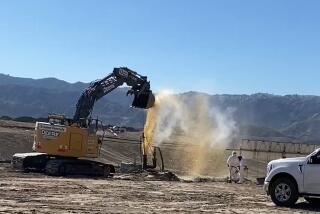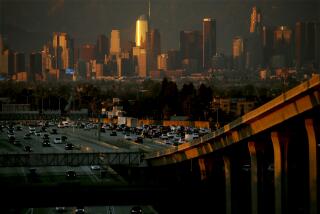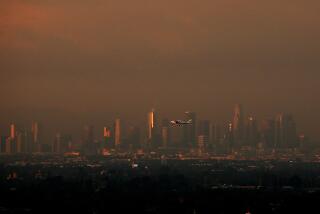Getty fire rains smoke and ash on Los Angeles Basin, creating hazardous air
The Getty fire was causing a bad air day for parts of Los Angeles as smoke billowed across the basin.
Areas around the Sepulveda Pass, Brentwood and Mandeville Canyon as well as points west were breathing smoke as ash rained down from the fire, which had burned several homes by 8 a.m. and had caused evacuations of more than 3,000 homes.
UCLA, Loyola Marymount and other colleges said they were monitoring air quality. Residents in Santa Monica and other Westside communities reported they had experienced smoke and ash from the fire.
Winds were expected to increase Monday, pushing hazardous air farther into the basin. Sustained winds from the northeast to the southwest could increase 20 to 30 mph, with gusts of up to 40 mph, National Weather Service meteorologist Lisa Phillips said. It’s possible winds could reach up to 45 mph.
Fire weather conditions were fueled by a Santa Ana wind event — a weather phenomenon typical in Southern California during this time of year.
Santa Ana winds are caused when high-pressure desert air over Nevada and Utah seeks a path through Southern California’s Transverse Ranges, which include the Santa Monica Mountains, to fill lower-pressure voids on the California coast.
Here are some tips for dealing with wildfire smoke from the Environmental Protection Agency.
Monitor air quality reports during a fire if you are:
- a person with heart or lung disease, such as heart failure, angina, ischemic heart disease, chronic obstructive pulmonary disease, emphysema or asthma.
- an older adult, which makes you more likely to have heart or lung disease than younger people.
- caring for children, including teenagers. Because their respiratory systems are still developing, they breathe more air (and air pollution) per pound of body weight than adults. They’re also more likely to be active outdoors, and they’re more likely to have asthma.
- a person with diabetes, because you are more likely to have underlying cardiovascular disease.
- a pregnant woman, because there could be potential health effects for both you and the developing fetus.
High concentrations of smoke can trigger a range of symptoms.
- Anyone may experience burning eyes, a runny nose, cough, phlegm, wheezing and difficulty breathing.
- If you have heart or lung disease, smoke may make your symptoms worse. People with heart disease might experience chest pain, palpitations, shortness of breath or fatigue. People with lung disease may not be able to breathe as deeply as usual and may experience coughing, chest discomfort, wheezing and shortness of breath.
More to Read
Start your day right
Sign up for Essential California for news, features and recommendations from the L.A. Times and beyond in your inbox six days a week.
You may occasionally receive promotional content from the Los Angeles Times.








